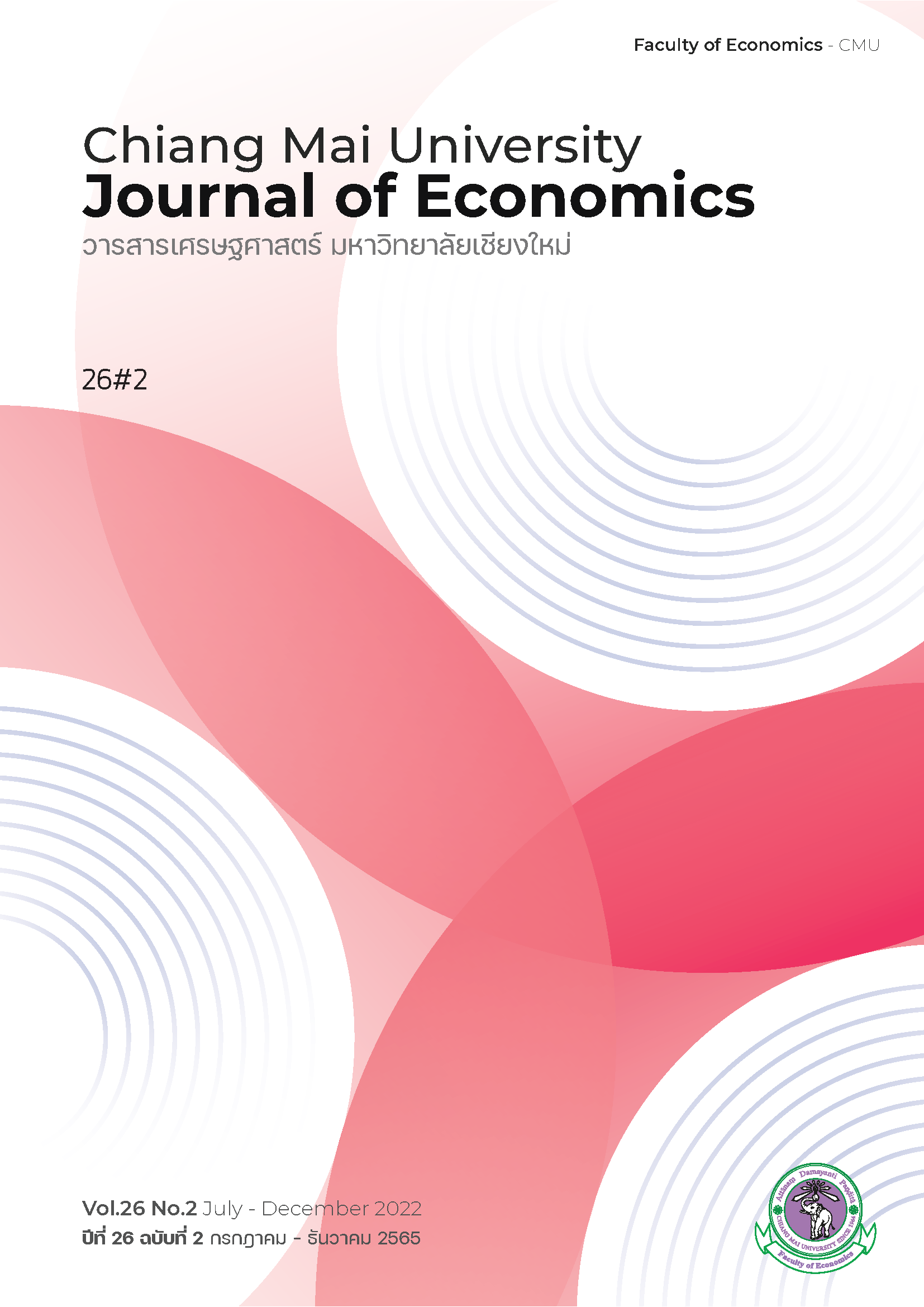Social Norms and Self-control in Adolescent Smoking Behavior
Keywords:
Smoking, Self -control, Nakhon RatchasimaAbstract
Cigarette smoking behavior remains a major health problem in many countries including Thailand. Some literature showed that social norms can influence a decision to adolescent smoking. Further, some studies in developed countries found that self-control behavior can also help to reduce the likelihood of smoking behavior. This study tried to test these findings by investigating the factors that influence adolescent smoking behavior. The primary data from a questionnaire collection were used using the purposive sampling method of the 300 individuals in the 2nd Engineer Regiment, Nakhon Ratchasima Province. The reason to select these samples is that the samples are staying together in the regiment, therefore, it is appropriate to test whether social norms affect smoking behavior or not. The data were analyzed using the logistic model. The results showed that (1) approximately half of the respondents were smokers (46%) and the average age of respondents was 26.1 years. Most respondents were single (80.4%) and graduated from high school level (41.3%). The average monthly income of respondents was about 12,545 baht. The average age that the respondents started smoking for the first time was 16 years old. The average number of cigarettes smoked per month was about 200 cigarettes and the average cigarette purchase was about 1,066 baht per month. (2) The factors affecting smoking decisions were that having close friends and relatives who smoke increased the likelihood of smoking decisions, as well as higher education and self-control behavior can help to reduce the likelihood of smoking decisions. However, the demographic variables, such as age and income were not correlated significantly with smoking behavior. Therefore, government policy should focus on the new smokers by avoiding the environments that encourage them to smoke. Furthermore, any measure (e.g., pre-commitment) that can improve the self-control behaviors of individuals would help to reduce the likelihood of smoking decisions of new smokers.
References
จรุณรักษ์ ยี่ภู่, อุษา คงทอง และบุญเรือง ศรีเหรัญ. (2561). การพัฒนารูปแบบกิจกรรมการเรียนรู้เพื่อ ลดละ เลิกพฤติกรรม การสูบบุหรี่ส าหรับผู้ป่วยยาเสพติดเด็กและวัยรุ่น. สืบค้นจาก
https://so06.tci-thaijo.org/index.php/var/article/view/146942/108280
จอมภัค คลังระหัด, ชนนิกานต์ บุญนาค และ ลลิตา เรืองวิไลเวทย์.(ม.ป.ป.). พฤติกรรมการสูบุหรี่ของนักศึกษา-หญิง. สืบค้นจาก
https://kukr.lib.ku.ac.th/proceedings/kucon/search_detail/dowload_digital_file/10702/13847
จักรพันธ์ เพ็ชรภูมิ ,ณรงค์ศักดิ์ หนูสอน ,พัฒนาวดี พัฒนถาบุตร ,กันยารัตน์ ธวัชชัยเจริญยิ่ง และ นฤญา ยางธิสาร.(2564). โครงการความชุกและปัจจัยที่มีผลต่อการใช้สารเสพติดมากกว่าหนึ่งชนิด ร่วมกันในวันเดียวกัน ของ นักศึกษาระดับอาชีวศึกษาในเขตภาคเหนือ. สืบค้นจาก
https://cads.in.th/cads/media/upload/1622083939-ความชุกและปัจจัยที่มีผลต่อการใช้สารเสพติด.pdf
จีรภทร์ รัตนชมภู.(25863). การป้องกันนักสูบหน้าใหม่ สังคมไทยต้องเปลี่ยนแปลง The New Smoker Protection: Thailand Society has to Modify. สืบค้นจาก
https://he01.tci-thaijo.org/index.php/unc/article/download/161968/165378/
นิยม จันทร์นวล และ พลากร สืบสำราญ. (2559). สถานการณ์การสบบุหรี่ของบุคลากรและนักศึกษามหา
วิทยาลยัอุบลราชธานี : ภายใต้โครงการมหาวิทยาลัยอุลบราชธานีปลอดบุหรี่. สืบค้นจาก
https://www.ubu.ac.th/web/files_up/08f2016081710150364.pdf
วีรวิท คงศักดิ์.(2557). ค่านิยมกับการพัฒนาสังคม. สืบค้นจาก
https://ethics.parliament.go.th/download/article/article_20160614141717.pdf
พนม กุณาวงค์ และ ภาคย์ ชูชื่น.(2557). ระดับการยอมรับของลูกค้าต่อการประชาสัมพันธ์ของ การประปา
ส่วนภูมิภาคสาขาเชียงใหม่. สืบค้นจาก http://cmuir.cmu.ac.th/handle/6653943832/39966
“พระราชบัญญัติ ควบคุมผลิตภัณฑ์ยาสูบ พ.ศ. 2560” ราชกิจจานุเบกษา. สืบค้นจาก
http://www.ratchakitcha.soc.go.th/DATA/PDF/2560/A/039/27.PDF
พรรณปพร ลีวิโรจน์, บุญรัตน์ โง้วตระกูล และ ดาริกา กูลแก้ว.(2560). ปัจจัยที่มีผลต่อพฤติกรรมการสูบบุหรี่ของวัยรุ่น นอกระบบการศึกษา และผลการพัฒนา โปรแกรมการปรับความคิดและพฤติกรรมเพื่อ ลดการสูบบุหรี่. สืบค้นจาก http://utcc2.utcc.ac.th/utccjournal/374/75_91.pdf
ไทยทีพีเอส. (2562). WHO เผยบุหรี่คร่าชีวิตทั่วโลก 8 ล้านคนต่อปี. สืบค้นจาก
https://news.thaipbs.or.th/content/280471
ธชาพิมพ์ อานพินิจนันท์.(2561). การสื่อสารเพื่อเสริมสร้างเจตคติ การคล้อยตามกลุ่มอ้างอิง การรับรู้การควบคุมพฤติกรรม และความตั้งใจที่มีผลต่อพฤติกรรมการงดสูบบุหรี่ของนักศึกษาในระดับมหาวิทยาลัย ตามแนวทฤษฎี พฤติกรรมตามแผน. สืบค้นจาก
http://dspace.bu.ac.th/handle/123456789/3509
เริงฤดี ปธานวนิช.( 2562). สธ.เผยคนตายเพราะบุหรี่ทุก 4 วิฯ-เยาวชน10%เป็นนักสูบ. สืบค้นจาก
https://www.tnnthailand.com/news/social/8627/
สารานุกรมไทยสำหรับเยาวชน ฉบับที่ 28. (2549). ผลกระทบของการสูบบุหรี่. สืบค้นจาก
https://www.saranukromthai.or.th/sub/book/book.php?book=28&chap=6&page=chap6.htm
สำนักควบคุมการบริโภคยาสูบ กรมควบคุมโรคกระทรวงสาธารณสุข. (2559). แผนยุทธศาสตร์การควบคุมยาสูบแห่งชาติ พ.ศ. 2559 – 2562. สืบค้นจาก
http://e-lib.ddc.moph.go.th/pdf/material_415/material 415.pdf
อภิชาติ เชื้อสีดา และ ประสิทธิ์ ลีระพันธ์. (2551). “พฤติกรรมการสูบบุหรี่ของนักเรียนจ่าทหารเรือ และ การตอบสนองต่อ นโยบายการควบคุมการบริโภคยาสูบของกองทัพเรือในโรงเรียนจ่าทหารเรือ”. สืบค้นจาก https://dric.nrct.go.th/Search/SearchDetail/207413
อัจฉราวรรณ สร้อยทอง. (2542). “ปัจจัยที่มีอิทธิพลต่อพฤติกรรมการสูบบุหรี่ในกลุ่มวัยรุ่น”. สืบค้นจาก
https://dric.nrct.go.th/index.php?/Search/SearchDetail/90768
Aggarwal อ้างถึงใน พรรณปพร ลีวิโรจน์ อรวรรณ คุณสนอง และเกสร ศรีอุทิศ.(2559). ปัจจัยที่มีความสัมพันธ์ต่อ พฤติกรรมการสูบบุหรี่ และผลการพัฒนาโปรแกรมการปรับความคิดและ พฤติกรรม เพื่อลดการสูบ บุหรี่ใน วัยรุ่นนอกระบบการศึกษา.สืบค้นจาก
http://www.trc.or.th/trcresearch/pdffiles/ART%2012/cat12%20(5).pdf
Chermerhorn, Hunt and Osborn ,1994 อ้างถึงใน Coure Hero.(ม.ป.ป.). Week 4 ค่านิยม ทัศนคติ และความพอใจในงาน. สืบค้นจาก https://www.coursehero.com/file/39079882/Week-4-ค่านิยม-ทัศนคติ-และความพอใจในงานpdf/
Cell Press. (2015). Trying to quit smoking? First strengthen self-control. ScienceDaily. Retrieved from www.sciencedaily.com/releases/2015/07/150730130729.htm
Christakis NA, Fowler JH. (2008). The collective dynamics of smoking in a large social network. The New England journal of medicine. 358(21): 2249–2258.
Daly, M., Delaney, L. and Baumeister, R.F. (2015) Self-control, future orientation, smoking, and the impact of Dutch tobacco control measures. Addictive Behaviors Reports. 1: 89-96.
Heckman, B. W., MacQueen, D. A., Marquinez, N. S., MacKillop, J., Bickel, W. K., & Brandon and T. H. (2017). Self-control depletion and nicotine deprivation as precipitants of smoking cessation failure: A human laboratory model. Retrieved from
https://psycnet.apa.org/record/2017-12488-007
Michael Daly , Liam Delaney and Roy F. Baumeister. (2015). Self-control, future orientation, smoking, and the impact of Dutch tobacco control measures. Retrieved from
https://www.sciencedirect.com/science/article/pii/S2352853215000280
Nancy Rhodes and David R. Ewoldsen .(2009).Attitude and Norm Accessibility and Cigarette Smoking. Retrieved from
https://onlinelibrary.wiley.com/doi/abs/10.1111/j.1559-1816.2009.00529.x
Randy M. Page Ph.D.; Ferenc Ihasz; Jaromir Simonek; Renata Klarova; and Iacob Hantiu.(2006).
Cigarette Smoking, Friendship Factors, and Social Norm Perceptions Among Central and Eastern European High School Students. Retrieved from
Shuaizhang Feng .(2004). Rationality and self-control: the implications for smoking cessation . Retrieved from https://www.sciencedirect.com/science/article/abs/pii/S1053535704000678
Susan J.Currya, LouisGrothausa and Colleen McBridea .(1998). Reasons for quitting: Intrinsic
and extrinsic motivation for smoking cessation in a population-based sample of smokers. Retrieved from https://www.sciencedirect.com/science/article/abs/pii/S0306460397000592
Downloads
Published
Issue
Section
License
Copyright (c) 2022 CHIANG MAI UNIVERSITY JOURNAL OF ECONOMICS

This work is licensed under a Creative Commons Attribution-NonCommercial-NoDerivatives 4.0 International License.
All opinions and contents in the CMJE are the responsibility of the author(s). Chiang Mai University Journal of Economics reserves the copyright for all published materials. Papers may not be reproduced in any form without the written permission from Chiang Mai University Journal of Economics.
ข้อคิดเห็นที่ปรากฏและแสดงในเนื้อหาบทความต่างๆในวารสารเศรษฐศาสตร์มหาวิทยาลัยเชียงใหม่ ถือเป็นความเห็นและความรับผิดชอบโดยตรงของผู้เขียนบทความนั้นๆ มิใช่เป็นความเห็นและความรับผิดชอบใดๆของวารสารเศรษฐศาสตร์ มหาวิทยาลัยเชียงใหม่
บทความ เนื้อหา และข้อมูล ฯลฯ ในวารสารเศรษฐศาสตร์มหาวิทยาลัยเชียงใหม่ ถือเป็นลิขสิทธิ์เฉพาะของคณะเศรษฐศาสตร์มหาวิทยาลัยเชียงใหม่ หากบุคคลหรือหน่วยงานใดต้องการนำทั้งหมดหรือส่วนหนึ่งส่วนใดไปเผยแพร่ต่อหรือเพื่อกระทำการใดๆ จะต้องได้รับอนุญาตเป็นลายลักษณ์อักษร จากวารสารเศรษฐศาสตร์ มหาวิทยาลัยเชียงใหม่





